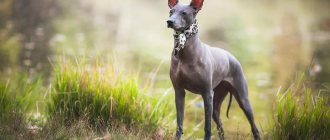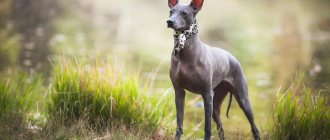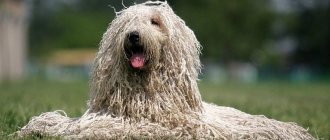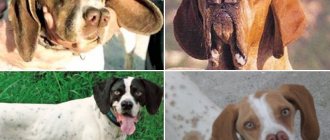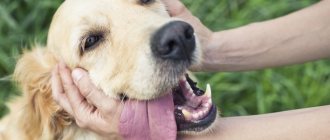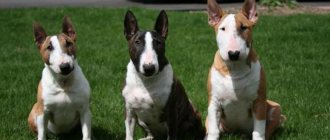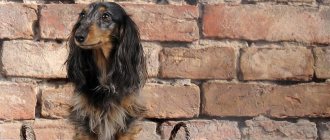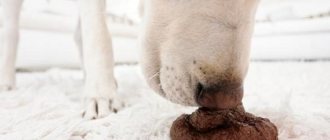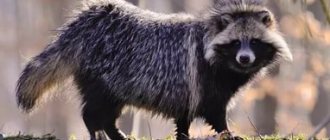The Peruvian Inca Orchid is an extraordinary name for a breed of an equally extraordinary dog. It is also called the Peruvian Hairless Dog. But there are also representatives with wool, called kalato or viringo.
As you can guess from the name, the breed is very ancient. It was developed back in the Inca era in Peru. Local residents consider this breed a treasure of the people. In ancient times, people thought that dogs had superpowers. During rituals they wore ceremonial clothes. The Peruvian Hairless was considered an animal that could keep people warm in bed while they slept.
History of the origin of the breed
In Spanish, the breed is called perro sin pelo del Peru, but it also has a more poetic name “Peruvian Inca orchid”, although it was known and bred in some cultures long before the Incas. The earliest archaeological finds depicting her date back to the third century BC. Burials with skeletons of Peruvian hairless dogs are found in Peru to this day. The Incas considered the Peruvian moon dog sacred, endowed it with mystical healing powers, and used it in rituals.
From the beginning of the sixteenth to the nineteenth centuries, the “hairless” breed almost became extinct, as it interbred uncontrollably with “wool” individuals. The process stopped when the Peruvian authorities banned their export and uncontrolled reproduction, which they declared to be the property of the nation. The Peruvian Hairless received recognition from the American Kennel Club in 1996, and from the International Canine Federation in 1981.
Brief historical background
The Peruvian hairless dog is the oldest indigenous dog breed native to Peru, it is declared a cultural heritage and symbol of this country . There is a lot of evidence and artifacts (frescoes, rock paintings, pottery, etc.) that the Inca orchid appeared long before the emergence of the ancient Indian civilization. The question of how the animals got to South America remains open. According to one version, they were brought to the continent from China by primitive settlers. According to another theory, they got there with nomads from Africa. Some researchers believe that hairless dogs arrived with Asian travelers passing through the Bering Strait.
Peruvian hairless dogs are the symbol of Peru
Peruvian orchids came to Europe at the very beginning of the 16th century, when several individuals were presented to Philip the Fair as a luxurious gift from the New World.
During the time of the Incas, hairless canids were extremely revered and considered sacred . The local population believed that they were messengers of the gods and attributed healing qualities to them. As a result of the Spanish invasion, when Inca orchids were mercilessly exterminated, the number of dogs decreased sharply. For a long time they were extremely few in number and practically unknown outside their homeland.
Until recently, Inca orchids were known only in their homeland
At the beginning of the 20th century, the Peruvian authorities began to restore the breed. The export of animals abroad was prohibited, and breeding was taken under state control. A group of enthusiastic dog handlers saved the unusual breed and practically re-bred it. In 1985, she received international recognition from the FCI, she was assigned to group 5 (section 6) under No. 310. At the same time, the first breed standard, developed by Ermanno Magniero, was approved. The latest valid official standard dates back to 08/13/2013.
Video: hairless dog from Peru
Description of the breed
Graceful, harmoniously built, fast dogs. Spotted individuals from afar look like deer. Their skin has a texture similar to that of humans. They seem hot to the touch, but this is due to the difference between normal dog (37.5 - 39 degrees) and human temperatures. Based on their “clothing”, individuals are distinguished between those with and without fur.
Breed standard
Head:
- wide at the top, wolf-like in structure;
- forehead and muzzle are parallel;
- an incomplete set of teeth (associated with the hairlessness gene) or no teeth at all;
- “dressed” dogs have a full set;
- Small Peruvian hairless cats, as a rule, have fewer teeth than medium and large hairless ones;
- scissor bite of incisors;
- the nose is pigmented, straight, the color is in harmony with the color of the skin (coat);
- the eyes are medium-sized, almond-shaped, attentive, the color of the iris (from yellow to black) is in harmony with the color;
- the ears are medium, triangular, laid back or at an angle of 50 - 90 degrees to each other;
- neck without dewlap, flexible.
Torso:
- the ratio of height at the withers to the oblique length of the body is 1:1, bitches are slightly elongated in length;
- the back is straight, strong, a convexity in the lower back is acceptable;
- the croup is rounded, inclined;
- The chest is deep, but not wide, the ribs are slightly curved;
- the underline is elegant, the belly is tucked in;
- the tail is slightly curved, lowered or raised.
Legs:
- medium, “hare” type;
- front vertical, not turned elbows;
- posterior vertical with rounded muscles;
- The pads are heat-resistant, there are membranes between the toes, and the claws are longer than average.
Naked skin:
- smooth, elastic skin with several rounded lines on the skull;
- color from black to white, monochromatic is preferred, pink or white spots are acceptable (on no more than 1/3 of the body surface);
- remnants of hair on the head, paws and tail; their absence is preferable.
Wool of “dressed” ones:
- smooth, close-fitting, very short, sparse hair;
- curly, waviness is unacceptable;
- any color.
| Growth variety | Height, cm | Weight, kg |
| big | 51 — 65 | 12 — 22 |
| average | 41 — 50 | 8 — 12 |
| small | 25 — 40 | 4 — 8 |
Diseases of the Hairless Peruvian Dog
In general, Peruvian corydalis have good health and strong immunity, but sometimes they suffer from the following problems:
- Bald individuals lose teeth (problems with the dentition are directly related to the hairlessness gene). There's nothing you can do about it. It is necessary to regularly show the animal to the dentist to remove tartar, treat caries, etc.
- There are problems with the skin (even oncology). If there are spots that do not go away for a long time and various suspicious formations on the skin, you should immediately take the dog to the veterinarian. Skin cancers are extremely dangerous and can be fatal very quickly.
- Allergic manifestations. They are characterized by all kinds of skin rashes, problems with the gastrointestinal tract, etc. The dog constantly itches and worries, scratching its skin even more. It is fraught with suppuration due to infection and even sepsis. It is necessary to carefully select food and care products (shampoos, creams, etc.).
Hairless Peruvian dogs live for about 11–14 years.
Character and behavioral characteristics
A balanced, alert guard and companion dog. He does not like to leave the house and the owner, to whom he becomes strongly attached; he may never get used to the new owner. He is jealous of his owner towards small dogs, respects large ones, and maintains polite neutrality with cats, but due to the instinct of a hunter, he can chase them. Doesn't trust strangers. “Wakes up” in the evening, prefers to stay awake at night.
A breed characteristic of the Peruvian Hairless is that it does not like to be touched by strangers.
Peruvian Inca Orchid
1K 6 min.
The Peruvian Inca orchid is, in essence, not “Inca” at all. Because at the time when this ancient indigenous breed of the American continent was born, there was no trace of the great Incas. Apparently, these orchids lived here already in the 3rd century BC, which is confirmed by their portraits on pots of the corresponding age. And in the graves of that (and many subsequent) eras, mummified dogs are found every now and then. The sad tradition of placing a dog under the side of the dear deceased was discovered by the conquistadors, who noted the local custom of raising hairless and always black dogs especially for funeral rites.
Photo: MaryEvans/VOSTOCK Photo
Photo: MaryEvans/VOSTOCK Photo
And, as you understand, they won’t put just anyone in the grave of their beloved relative. If you’re going to bury a dog, it’s certainly a sacred one—and the Incas declared orchids to be just that. And this means that these dogs can no longer be eaten - which is not bad, because before, in pre-imperial times, they were eaten and nothing like that was thought about. But how is this possible if sacred dogs can accompany the dead on their difficult journey to the next world? Well, while people were alive, orchids could improve their health: they were especially successful in coping with asthma and stomach ailments, this was their specialization. Moreover, to improve stomach problems, it was enough to hug the dog tightly. I don’t know what about the stomach, but this dog, of course, helped keep me warm on the cold Andean nights - after all, it is very warm, because it is naked.
In the intervals between solving stomach problems and lavish funerals, many Peruvian orchids either, dressed to the nines, took part in religious ceremonies, or performed the functions of a greyhound: the larger and furrier ones were taken by the Indians with them on hunting trips.
Yes, among them there are also quite woolly specimens, this is normal for hairless dogs, in which usually about a third of the puppies in the litter are to some extent hairy. At the same time, they are still officially considered to be naked, because they have the hairless gene. And these woolly specimens are simply necessary for the development of the breed, because marrying two completely hairless dogs is not always good, for which there are some murky but irrevocable genetic reasons.
As for size, the Inca orchid has the right to three options: small (25-40 cm at the withers, weight about 4-8 kg), medium (height - 41-50 cm, weight - 8-12 kg) and large (51 –65 cm and 12–30 kg). That is, the large Peruvian Inca orchid - it is really quite large, you can hunt with it.
Well, the small one is the rarest. However, the rest of the orchid varieties are also not exactly in shoals - this breed is still extremely exotic. At least she's no longer disappearing. But it was: after the Spaniards dealt with the Inca Empire, the sacred dogs also began to die out. But they did this gradually, so a small fraction of them managed to survive until the last century. And then patriotic enthusiasts stepped up and began to save the remnants of the former luxury. Well, in the 1960s, the breed entered the United States, and then they took it seriously. In short, in 1981, things were going so well for orchids that they received official recognition; another 20 years later they were designated a national treasure of Peru. And now they are slowly spreading throughout the inhabited universe, so that anyone can get a personal orchid (only thousands for 60–80 rubles and, of course, not right away: the breed is rare, you need to look for puppies and wait).
As for the name of the breed, it has many names. The most formal and boring is the “Peruvian hairless dog.” However, the “Peruvian Inca Orchid” is also quite official. But in various corners of the former Inca Empire this breed is called as they are accustomed to - somewhere “viringo”, somewhere “calato”, somewhere “aiko”, somewhere “kakiya”. It sounds exotic, but I'm afraid it all translates to just "naked dog" in various tribal languages. This dog is also called lunar and even moonflower. This is because of one very strange breed trait: Peruvian orchids have a tendency to be nocturnal! Somehow this is not very dog-like, and yet: during the day, most representatives of this breed behave rather sluggishly. But in the evening they come to life and with all their behavior they pretend to be ready to party all night until the morning. In a word, it is worth communicating and especially teaching them canine wisdom in the evening, when this atypical dog is in the best head and is in the most wonderful mood.
Well, this southern dog doesn’t like the sun. Apparently, she understands how dangerous it is for her: bare skin quickly burns, so if you have to take the orchid outside on a summer day, you will have to smear it with sunscreen (of course, this does not apply to hairy specimens). However, she doesn’t like frost either - but that’s understandable!
The smooth, elastic skin of an orchid resembles that of a human to the touch - this dog, they say, can even sweat as well as you and I (which means that it does not need to cool itself by sticking out its tongue, so it doesn’t stick it out). And it is just as easy to damage its unprotected skin, so this delicate lunar flower must be protected from injury and scratches, like a human baby.
The hairless dogs of the Incas, who were destined to be born not hairless, are covered with not very serious hair - short, not too thick, close to the body, without undercoat and in no case curly. Well, hairless dogs are actually not always so completely bald either: they often have a hard fringe on their heads, tufts of hair on their paws and a tuft at the tip of their tail. With the contours of their body, orchids most closely resemble a small deer - the similarity is further aggravated by the rather high, horn-like ears, if the dog deigns to raise them warily.
The shape of the orchid is sculptural, the very long slender neck is especially beautiful, we all wish we had one! It’s immediately obvious: our moonflower is not a fragile flower, but a completely strong, fast, energetic, strong and healthy creature, possessing all the attributes of a real dog. Well, except for wool, of course. And except for the teeth, everything somehow didn’t work out. That is, she either has far fewer teeth than required, or does not have them at all and never has had them. Moreover, this is so normal for these dogs that it is in no way considered a defect - for example, a breed feature characteristic only of hairless variations of this breed (in wool orchids with teeth everything is more or less traditional).
But how, you ask about the toothless, do they eat? They eat very well. True, they are unlikely to be able to gnaw bones, as well as crunch dry food, but otherwise no problems were noticed with their feeding.
Besides, if someone has no teeth, he is unlikely to bite. And the delicate orchid might want to bite - if suddenly all sorts of strangers began to touch it. She really doesn't like it! But in the absence of terrible teeth, she has to demonstrate her dislike with just one facial expression - she makes all sorts of sad and gloomy faces perfectly. Of course, she is a companion dog. But it’s not for everyone! She agrees to be a dear friend only to her own people; she is gentle with her family and tries to stay somewhere nearby all the time. Well, everyone else went out. Moreover, it would be better to go far away: orchids are territorial dogs and guard their real estate like the apple of their eye. That is, they are also excellent, vigilant guards.
As for colors, there are a lot of options available. Plain or speckled, black, gray, white, yellow, bluish, brown, orchids are good in all their forms. Recently, it has become fashionable for dogs to be of the same color, without any special spots characteristic of this breed... But what about without speckled spots, unusual pink or white markings? After all, these dogs were called orchids precisely because of these special spots.
With the exception of difficulties with teeth, the rest of these Peruvians’ health is quite decent, and their life span is 15 years, which is also quite traditional. This dog does not require any out of the ordinary troubles - with the exception of skin care. It is harmful to wash it often, especially with shampoo: this breed is especially sensitive to any chemicals. But the Peruvian woman will have to be anointed with something every now and then - either sun cream or something moisturizing: the skin of orchids, especially on the ears, tends to dry out.
These and other hairless dogs are highly recommended for allergy sufferers - but this is in vain, they still emit allergens. But for people obsessed with a clean home, the naked Peruvian orchid is very suitable, since due to the lack of fur it does not shed and does not smell like a dog. It will also suit lazy owners - although the orchid has a greyhound past, it does not need long active walks. So, have a little fun in the evening, and that’s enough for her. She learns quite quickly, because she is smart and not lazy, she obeys not unquestioningly, but within the limits of what is permissible. Affectionate, but in moderation - that is, you can cuddle with it, but this dog does not intend to hurt itself into a cake just to capture the attention of its owner. In general, the Peruvian Inca Orchid has all the makings of being pleasant to spend time in its company - it literally radiates calm friendliness.
It also radiates warmth, which is very useful on long winter evenings.
And she doesn't drool.
Education and training
The Peruvian Hairless is an intelligent, quick-witted breed that is easy to raise and train, especially if you use rewards such as treats. She is very sensitive and does not tolerate harshness. It is better to ban something gently. For the same reason, socialize your orchid very gradually so that she does not lose confidence in herself. The best age to start training is 8 - 12 weeks. When you start training, consider your pet's natural sleep-wake cycle: train in the late afternoon. Short workouts are better than long ones.
Diseases and care
The breed is healthy, but dogs have a hard time withstanding heat and frost, since the entire surface of the body is involved in thermoregulation (sweating), and not just the protruding tongue. To exist normally in the Russian climate, the Inca “orchid” always needs shade in the summer and warm clothes in the winter. The skin of the ears is especially thin and cracks easily.
Monitor the condition of your bare skin, do not allow it to dry out (use lotions and creams) and injury. Do not bathe “wool” dogs too often, shampoos should be gentle, and during shedding, comb the coat to remove fluff. To make your pet completely happy, let him be active outside, but on a leash or in an area with a high fence. If you train him to use a litter box, he can sometimes do without walking. It is necessary to trim their nails (they are longer than usual for dogs), wash their eyes and brush their teeth daily.
Hairless Inca dogs are predisposed to:
- dental diseases (tartar, inflammation of the gums), up to tooth loss (begin in the second year, lack of teeth is not a defect);
- skin injuries and diseases, including cancer and sunburn (promotes hairlessness);
- epilepsy;
- inflammation of the pancreas,
- allergies.
Temperament[edit]
The breed's hairless bodies radiate heat. Many in Peru use dogs as living heating pads for warmth at night or for pain relief. They are smart, caring for family, but wary of strangers, [ citation needed
]and is very protective of the women and children in the family. The breed is generally lively, attentive and friendly with other dogs. They are agile and fast, and many of them like to hunt small rodents. These dogs do not like to be left alone, but can do well with training. They tend to know their permitted territories and respect them. These dogs cannot tolerate extreme temperatures, although they are quite comfortable in clothes, and if dressed warmly, they will even play in the snow. They usually require an owner who understands canine language and are not recommended for beginners. They learn quickly and are very smart, but they quickly get bored with repetitive games such as fetch.
Feeding
Dogs of this breed often suffer from intestinal disorders, so give them light but nutritious food. It will take a long time to select it, taking into account the vagaries of the pet. But there are animals that eat everything that the owner offers.
Preferred Products:
- beef, chicken (with caution),
- fish (with caution)
- cereals,
- cottage cheese and kefir,
- raw carrots and pumpkin.
Avoid these foods:
- pork, smoked meats,
- sweets, including baked goods,
- fish, bird bones,
- grape.
Buy dry food of premium class and higher, supplement the natural diet with vitamin and mineral complexes. Feed at the same time every day.
Nutrition
Most breeders and owners prefer to feed the Peruvian orchid with ready-made dry or wet food of super-premium or holistic class. Food is selected taking into account the dog’s age, size, physiological condition and, of course, taste preferences. Veterinarians note a tendency for hairless dogs to develop allergies and gain excess weight. With age, when the Peruvian begins to lose teeth, they switch to canned food or soak dry food.
How to choose a puppy
- Inspect the puppy visually (health and cleanliness of the skin, eyes, anus, nose), pay attention to his activity, curiosity, his environment, brothers/sisters.
- “Undressed” puppies are always born dark or light, the spots appear later.
- In one litter there are both naked and “dressed” puppies - this is not a sign of unclean breeding, but a normal phenomenon.
- Find out if there are any hereditary diseases in your family tree (pancreatitis, cancer, epilepsy).
- Check for documents and stamps.
How to make a diet
Representatives of the Xolo breed are prone to allergies, so it is important to approach menu planning for them responsibly. To avoid mistakes, it is better to abandon natural food in favor of ready-made industrial products intended for dogs with allergies.
It is important that the composition contains a sufficient amount of protein and does not contain any food coloring or other chemicals.
Note! As your pet ages, his teeth will inevitably begin to crumble and fall out, so he is gradually transferred to soft canned food of at least super-premium class. If you have some experience in keeping dogs, the use of natural food is allowed; in this case, the diet should consist of 60% protein-rich lean white meat
If you have some experience in keeping dogs, the use of natural food is allowed; in this case, the diet should consist of 60% protein-rich lean white meat.
It is unacceptable for the following products to get into your Xolo's bowl:
- pork;
- river fish, even boiled;
- sweet;
- white bread, other pastries;
- alcohol;
- smoked and semi-finished products (sausages, stewed meat, canned fish for people).
The exception to sweets is apples. They can be given to enrich with vitamins and clean teeth.
The dog needs round-the-clock access to clean water; it is changed in the bowl at least twice a day.
A properly formulated diet is the key to a dog’s health and longevity.
Price and where to buy a puppy
Prices for Peruvian Orchid puppies range from $1000 to $1200.
Nurseries:
- Magic of the Incas, Moscow,
- Icefire, St. Petersburg,
- Sonderwol Legend, Moscow region, Vidnoye,
- Van Edelsieger,
- Status Imperial,
- Luramion, Czech Republic.
Choosing a nickname
The character of these animals is best suited to playful, sonorous nicknames. Let them be firmly associated with your active or affectionate dog. Perhaps the name for your pet will “tell you” the size and color of the future adult dog.
| Suitable for boys: | Archie, Thunder, Guy, Genghis, Paki, Luke, Poncho, Plato, Zod. |
| The girl can be called: | Inka, Dana, Akira, Naomi, Amber, Yusta, Laida. |
Dossier
Height of an adult dog: miniature - 25-40 cm, medium - 40-50 cm, standard 50-65 cm. Weight: miniature - 4-8 kg, medium - 8-12 kg, standard - 11-22 kg. Characteristic color: black, dark blue, brown, graphite, light fawn, ivory. Hair length: no hair. Life expectancy: up to 14 years. Advantages of the breed: cheerful, active, makes an excellent companion, easy to train. Difficulties of the breed: jealous, loves to demonstrate its superiority over other animals. Requires special, constant care. Average price: $1,000. Classification: small, medium, large, hunting.
Owner reviews
“I took the puppy through the ad “I’ll give it to good hands,” and since then the impressions of living together with this bald miracle have been only positive. The plus side is that there are no tufts of fur on the furniture or floor, Alpha is friendly and eats mostly vegetables, greens and some meat. It seems to be considered hypoallergenic, but it is not. She is obedient and loves the sun very, very much. And she's warm. In winter she warms my bed.”
“This is truly the most special breed, but... not everyone is excited about it. Every trip for a walk is an adventure; every time I’m sure to hear the question “What kind of dog is this?” Although I have a miniature dog, he is not weak at all, on the contrary, he is strong. Very affectionate: he will always climb onto your lap, cuddle, kiss, grumble if you try to get him off your hands. Mine has all the teeth, and there are no problems with choosing food. If you don't like quivering dogs, then naked orchids are not your dog. And he’s also smart, so refined. Predictable".
“We already have a Don Sphynx - a hairless cat, now my husband also has a hairless dog! She turned out to be a very kind, playful and affectionate girl. It’s annoying that they often ask why we shave it. It is excusable that the breed is very rare, we are the only ones in our city. Her bare skin takes some getting used to, but those who don't have the option show disgust. But more often they admire her. It simply does not evoke a third feeling. He is friends with our cats and toy terrier. With the latter, water is inseparable; they even sleep together.”
Who is it suitable for?
A “bald” dog, as the Xolo is sometimes unkindly called, is a dog only for those who love animals and are ready to take care of them. A representative of the Mexican breed is categorically not recommended for busy people who are constantly missing at work. A pet needs communication with its owner, without whom it will suffer.
In addition, families with children should choose another purebred puppy
A tiny naked dog is not a living toy; careless movement of a child can cause injury
The Mexican Hairless Dog is suitable for those who are willing to devote time and attention to it.
Xolo is suitable for responsible and serious people who already have experience in keeping dogs. The breed, for all its attractiveness, is distinguished by its disobedience, so the dog needs a strict but fair owner.
It is important to soberly assess your strengths, to understand whether it will be possible to constantly make preventive visits to the veterinarian, buy expensive food and clothing, shoes, and oil for skin care for your pet. If yes, then you can safely head to the nursery
Advantages and disadvantages
| Pros: | Minuses: |
|
|
Chinese Crested
The Chinese Crested is a hairless indoor breed, bred in China specifically for home keeping, characterized by short thin legs and large coal-black eyes, similar to olives. The tips of the ears, paws and tail are covered with hanging woolen “tufts”. The animal's height is 28-33 cm. Crested cats get along well with other pets, treat all family members with respect, and love to play with small children without showing signs of aggression. They are smart, but can be capricious and stubborn, curious and slightly obsessive. Their delicate skin is quite sensitive to even a slight drop in temperature, so try to protect your pet from drafts. In the cold season, wear special insulated overalls for a walk. Use hypoallergenic shampoos to care for your skin. Baby soap (0+) is also suitable.
Chinese Crested
Similar breeds
The Chinese Crested Dog is a hairless or lightly coated dog with long hair on the head, tail and legs.
The Xoloitzcuintle, or Xolo, or Mexican Hairless Dog, is considered the oldest breed of dog on Earth; are a national treasure of Mexico.
The Pharaoh Hound is a primitive breed (according to the FCI classification) of Maltese origin, it hunts in the manner of a greyhound - it pursues in a sighted manner.
Cirneco dell'Etna is a breed bred in Sicily for hunting, chasing a hare like a greyhound.
The Basenji, or Congo Terrier, or Zande dog, is an ancient African hunting breed that does not bark.
The American Hairless Terrier is a companion dog breed not recognized by the FCI and is descended from the Rat Terrier.
Canarian Podencos are very fast hunting dogs with a good sense of smell and eyesight, related to Pharaoh Hounds.
Health and life expectancy
Most Peruvian orchids are in good health. Hereditary diseases occur with varying frequencies in different lines, and some diseases or predisposition to them are associated with a lack of hair.
- Skin problems, including malignant and benign tumors;
- Epilepsy;
- Allergy;
- Pancreatitis and other gastrointestinal problems.
- From about 2 years of age, hairless dogs begin to lose teeth.
The average lifespan of a Peruvian orchid is 11-13 years. Hairless dogs need standard veterinary preventive measures: regular medical examinations, vaccinations, treatment for external and internal parasites.
Some insecticides can be toxic to them and you need to be careful when using them.
Features of genetics
The hairlessness of the Peruvian Hairless Dog is caused by a dominant gene. Its effect is characterized by the presence of residual sparse hair on the tail, legs, head and ears, as well as abnormalities of the dental system, up to the complete absence of teeth. According to research, three breeds: Peruvian, Mexican and Chinese Crested have a similar genetic basis. In the American Hairless Terrier, the lack of hair is caused by another, recessive gene, and therefore is not associated with changes in the dental system.
Photo
Briefly about the main thing
- The Peruvian Hairless Dog is a very ancient breed, the national treasure of Peru.
- Touching a dog's hot skin relieves pain in humans.
- The Inca orchid has a peculiarity - an incomplete dental formula, which is why vegetarians are often found among them.
Write in the comments whether you like hairless animals in general and Peruvian hairless dogs in particular.
Did you like the article? Share it with your friends on social media. networks. This will help them get useful information and support our project.
Content Features
The Peruvian Hairless Dog is great for living in a house or apartment. Naturally, enclosure keeping is contraindicated for her. The skin of hairless dogs is sensitive to cold and ultraviolet radiation. In summer it tans very quickly. Sunbathing is dosed or the dog is protected with sunscreen. To maintain health and fitness, it is important for orchids to exercise a lot, and given that they are greyhounds in the past, they need the opportunity to run freely. Games with friends are welcome. Swimming is a useful activity if your dog loves water.
Hairless Peruvian Dog Clothes
For walks in cold weather, choose clothes and shoes according to the weather. Dogs begin to be warmed at a temperature of about +5°C. Clothing for these dogs is not a whim of the owners, but an urgent need. In summer, T-shirts protect you from the scorching sun. With the onset of cold weather, blankets, sweaters, and jackets will allow the dog to walk outside longer and not develop hypothermia or frostbite. Clothing must be appropriate for the size, weather conditions, and not hinder the dog’s movements. In frosty weather, be sure to protect the thin auricle with a hat to prevent frostbite.
Care
Caring for a Peruvian Hairless dog is not as difficult as it may seem. Remaining fur is usually combed after bathing. The frequency of washing is individual. After bathing, the skin is lubricated with moisturizing oil. Cosmetics are selected individually. These can be professional products for dogs or hypoallergenic products for children.
As adults, hairless dogs, like humans, develop wrinkles. An elderly Peruvian dog can be seen in the photo in the gallery.
Coated dogs are groomed regularly with a comb and brush. Particular attention is paid to the area behind the ears, where the fur is soft and prone to matting. Molting lasts 2-3 weeks. The rest of the time the dogs don't show up. Woolies are bathed no more than 5-6 times a year, otherwise the coat can become very sparse, dull and unkempt. This does not apply to the paws and belly, which are rinsed after a walk if necessary.
Ears are cleaned once a week. Puppies around 3 months of age often have their ears fixed in a standing position to help the cartilage strengthen. Ears rarely stand up on their own. In summer, they try to moisturize the ears more often, not allowing the thin skin to dry out. Nails are trimmed as needed, usually every 3-4 weeks. Particular attention should be paid to the teeth and oral cavity. Regular brushing will not protect your dog from losing teeth, but it will prevent tartar and keep the remaining teeth as healthy as possible.
